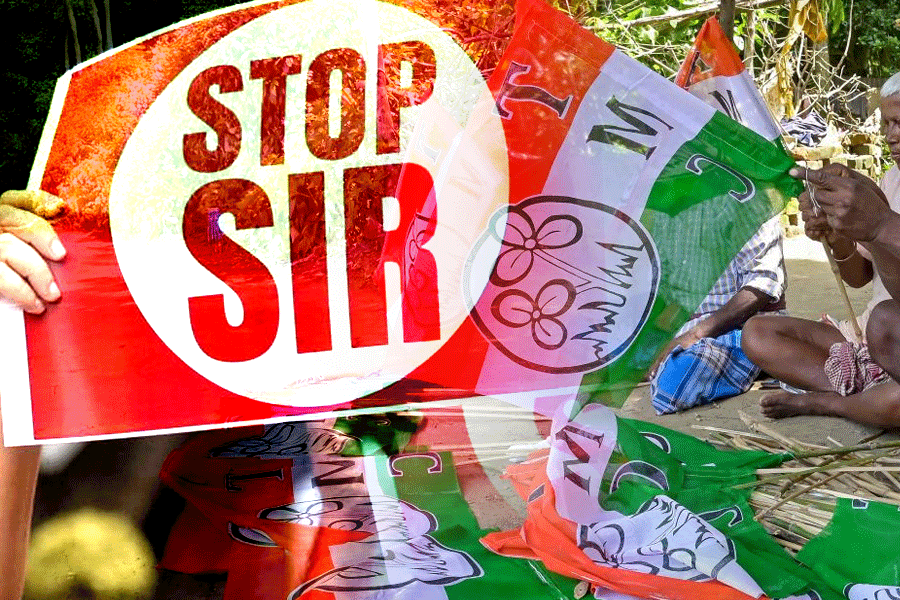 |
| MUSHROOM BABY CORN CHICKEN |
Calcutta’s links with the Chinese community are as old as the hills. But the first settler, over 220 years ago, was Yong Atchew — after whom Achipur outside Calcutta is named. The Calcutta Cook Book tells how he was granted land by Governor-General Hastings for a sugar plantation around 1780. So a group of 150 workers came to Bengal from China to work on the plantation. When Atchew died in 1783 — he was buried in Achipur — the workers moved to Calcutta.
Since then, of course, the Chinese have come to Calcutta for various reasons — for trade, to escape persecution and so on. Chinatown was set up, and Chinese food became a veritable part of the adventurous Bengali’s life as well. And even now, I find that Tangra holds a special place in the Bengali’s heart. You haven’t eaten Chinese if you haven’t had a meal at Tangra, many of my friends like to intone.
When you enter Tangra, you realise what a bustling area it once was. The restaurants started in the homes of the Chinese people. From the kitchen came bowls of hot noodle soups. Now, after the tanneries are all but gone, the restaurants are as swanky as they can get. You go through a maze of lanes, and suddenly stop in front of a big eatery. In some corners, you find Chinese lanterns lighting up the way.
 |
| FISH ROLLS |
Tangra chefs have been doing very well outside Calcutta as well. Chef Nelson Wang, who made his name in Mumbai, is from Chinatown, as is chef Jerry Wong, who now runs a place called The Jerry Wong in Saket. A great many Tangra chefs have migrated to Canada and the United States, where they have opened up Tangra restaurants. New York has two such restaurants — called the Tangra Wok and Tangra Masala.
I first got a taste of Tangra food outside Calcutta in Shangri La in Delhi. We used to be regulars there and once asked to meet the chef. That’s how I met Jerry Wong. Chef Jerry tells me that what makes Tangra food unique is the home-cooked touch. Because the restaurants were all home-run eateries to begin with, Tangra chefs have continued with the tradition of cooking for their clients as they would at home.
Of course, many Tangra restaurants at the same time have gone through a metamorphosis — mainly to suit different kinds of palates. My meal at Kafulok in Tangra was particularly good because the chefs did not try and soup up — or tone down — a dish to suit our tastes. What we got instead — from fish rolls, mushroom baby corn chicken and steamed bekti to garlic prawns and shanghai chicken (see recipes) — were the real McCoys.
 |
| STEAMED BEKTI |
But Chef Walter Chen of Kafulok tells me that they have to adapt their dishes every now and then to keep their clientele happy. For instance, for fish rolls — fried fish with a light corn starch batter, wrapped around a spring onion and egg — they use a “Bombay masala” to marinate the fish. The masala comes from Mumbai, and consists of the usual Indian spices.
Tangra food was originally Hakka food — which was essentially steamed and boiled Chinese cuisine. Cantonese – with more of the fried stuff — was added on to the menu over the years. Now, of course, they have everything that the patrons want — from the spicy Schezwan and Hunnan to even fusion Chinese.
But I think Tangra has evolved a cuisine of its own. And though we have seen an influx of chefs from China in recent years at some of the country’s top restaurants, Tangra continues to flourish. Clearly,Tangra’s heritage is its treasure. And as Confucius says, study the past if you would define the future.
Garlic prawns
 |
Ingredients (to serve 4)
• 10 medium-sized prawns • 4 garlic cloves • 10 leaves of spinach with stems • 1 tbs soya sauce • 250 ml chicken broth • Salt to taste • Cornstarch for coating and thickening
Method:
Stir fry the spinach and place it on a plate. Pan fry the prawns coated with cornstarch and set aside. Chop the garlic into small pieces. Stir fry the garlic, and then add the prawns to it. Add the chicken broth, soya and salt. Thicken the gravy with some corn starch. Put the cooked prawns on the spinach and serve.
Shanghai chicken
 |
Ingredients (to serve 4)
• 500g chicken ½ small onion finely chopped • 1 celery stem, finely chopped • 2 garlic cloves, finely chopped • 3 tbs tomato sauce • 1 tsp chilli sauce • 150ml chicken broth • 1 tbs soya sauce • Salt to taste • Cornstarch for coating and thickening
Method
Dice the chicken into 20 pieces. Fry coated with cornstarch. Set aside. Stir fry garlic and onion. Add the chicken to it. Add tomato sauce, chilli sauce and soya sauce. Add the chicken broth and salt to taste. Thicken the gravy with cornstarch. Add celery and serve.











